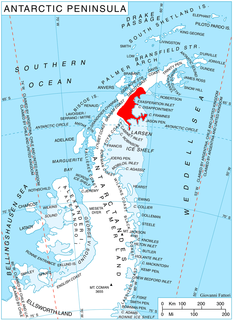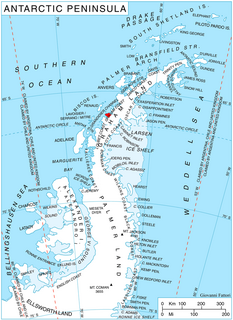
The Prince Charles Mountains are a major group of mountains in Mac. Robertson Land in Antarctica, including the Athos Range, the Porthos Range, and the Aramis Range. The highest peak is Mount Menzies. Other prominent peaks are Mount Izabelle and Mount Stinear. These mountains together with other scattered peaks form an arc about 260 miles long, extending from the vicinity of Mount Starlight in the north to Goodspeed Nunataks in the south.

Shiver Point is a point, surmounted by a peak 670 cm high, 8 miles (13 km) west of Cape Fairweather on the east coast of Graham Land, Antarctica forming the west side of the entrance to Artanes Bae and the northeast side of the entrance to Vagan Inlet.

Prospect Point is a headland at the west extremity of Velingrad Peninsula on Graham Coast in Graham Land, nearly 2 nautical miles (3.7 km) south of Ferin Head and immediately east of the Fish Islands. Roughly charted by the British Graham Land Expedition (BGLE) under Rymill, 1934-37. Photographed by Hunting Aerosurveys Ltd. in 1956-57. The name was suggested in 1957 by E. P. Arrowsmith, Governor of the Falkland Islands.

Birley Glacier is a glacier, at least 10 nautical miles (19 km) long, flowing west into the eastern extremity of Barilari Bay north of Vardun Point, on the west coast of Graham Land. First seen and roughly surveyed in 1909 by the French Antarctic Expedition under Jean-Baptiste Charcot, it was re-surveyed in 1935–36 by the British Graham Land Expedition (BGLE) under John Rymill, and later named for Kenneth P. Birley, who contributed toward the cost of the BGLE, 1934–37.
Blackface Point is a rocky and precipitous headland 3 nautical miles (6 km) northwest of Cape Freeman on the east coast of Graham Land. The point was photographed by the United States Antarctic Service, 1939–41, and mapped by the Falkland Islands Dependencies Survey, 1947–48. It was named by the UK Antarctic Place-Names Committee in description of the extremely black rock exposed at the end of the point.

Jorum Glacier is a glacier draining the southeast slopes of Forbidden Plateau, and flowing east along the north side of Austa Ridge into Borima Bay southwest of Furen Point, on the east coast of Graham Land, Antarctica. It was surveyed by the Falkland Islands Dependencies Survey in 1947 and 1955. The UK Antarctic Place-Names Committee name alludes to the punchbowl shape of the head of the glacier, a "jorum" being a large drinking bowl used for punch.
Dot Island in the sub-Antarctic is a tiny island lying 0.6 nautical miles (1.1 km) west of Tern Island in the south part of the Bay of Isles, South Georgia. It was first charted by Robert Cushman Murphy in 1912–13 and surveyed in 1929–30 by Discovery Investigations personnel, who probably so named it because of its size and minute appearance when represented on charts.
Fenton Glacier is a glacier that drains south into Mosby Glacier just east of Mount Adkins in Palmer Land, Antarctica. It was mapped by the United States Geological Survey from ground surveys and U.S. Navy air photos, 1961–67, and was named by the Advisory Committee on Antarctic Names for Lieutenant Ernest R. Fenton, U.S. Navy, Officer-in-Charge of Palmer Station in 1971.
Fricker Glacier is a glacier, 10 nautical miles (19 km) long, which lies close north of Monnier Point and flows in a northeasterly direction into the southwest side of Mill Inlet, on the east coast of Graham Land, Antarctica. It was charted by the Falkland Islands Dependencies Survey (FIDS) and photographed from the air by the Ronne Antarctic Research Expedition in 1947, and was named by the FIDS for Karl Fricker, a German Antarctic historian.
Mitchell Point is a point at the south side of the entrance to Hill Bay on the east coast of Brabant Island, in the Palmer Archipelago, Antarctica. It was photographed by Hunting Aerosurveys Ltd in 1956–57, and was mapped from these photos in 1959. The point was named by the UK Antarctic Place-Names Committee for American surgeon Silas W. Mitchell, the founder of neurology in the United States.
Mello Nunatak is an isolated nunatak standing 7 nautical miles (13 km) east of Mount Staley in the Freyberg Mountains of Antarctica, in the northeastern part of Evans Névé. It was mapped by the United States Geological Survey from surveys and U.S. Navy air photos, 1960–64, and was named by the Advisory Committee on Antarctic Names for chief engineman Gerald L. Mello, U.S. Navy, petty officer in charge of Hallett Station, summer 1966–67, and a member of the McMurdo Station winter party of 1967.

Hektoria Glacier is a glacier flowing south from the area around Mount Johnston between Mount Quandary and Zagreus Ridge into Vaughan Inlet next west of Brenitsa Glacier and east of Green Glacier, on the east coast of the Antarctic Peninsula.

Hodge Escarpment is an escarpment to the northeast of Henderson Bluff on the northwest side of Lexington Table, in the Forrestal Range of the Pensacola Mountains, Antarctica. It was named by the Advisory Committee on Antarctic Names for Steven M. Hodge, a United States Geological Survey geophysicist, who worked in the Dufek Massif and the Forrestal Range, 1978–79.
Hervéou Point is a point forming the western extremity of the rocky peninsula between Port Charcot and Salpetriere Bay, on the west side of Booth Island in the Wilhelm Archipelago, Antarctica. It was first charted by the French Antarctic Expedition, 1903–05, under Jean-Baptiste Charcot, and named by him for F. Hervéou, a seaman on the Français.
McCaw Ridge is an isolated ridge lying 4 nautical miles (7 km) south of the central part of Ueda Glacier, near the base of the Antarctic Peninsula. It was mapped by the United States Geological Survey from surveys and U.S. Navy air photos, 1961–67, and was named by the Advisory Committee on Antarctic Names for D. McCaw, a construction electrician at South Pole Station in 1963.
Tent Nunatak is a conspicuous pyramidal nunatak marking the south limit of Whirlwind Inlet on the east coast of Graham Land. First seen and photographed from the air by the United States Antarctic Service (USAS), in 1940, and described as a "distinctive tentshaped rock nunatak." It was charted by the Falkland Islands Dependencies Survey (FIDS) in 1947.
Tonkin Island is a narrow, ice-capped island in Antarctica. It is 3.5 nautical miles (6 km) long in a north-south direction, marked by ice-free peaks at each end, lying 11 nautical miles (20 km) southeast of Choyce Point, Bowman Coast, in Larsen Ice Shelf. The island was discovered and photographed from the air by the United States Antarctic Service (USAS) in 1940. It was charted by the Falkland Islands Dependencies Survey (FIDS) in 1947 and named after John E. Tonkin, FIDS general assistant at Stonington Island, 1945–47; named Lewis Island by Ronne Antarctic Research Expedition (RARE) following additional aerial photography, 1947. The names Isla Mateo de Toro Zambrano and Isla Riquelme, referring to the north and south parts of this feature shown as two islands, appear on a Chilean hydrographic chart, 1947.
Todd Glacier is a glacier 7 nautical miles (13 km) long flowing southwest into Calmette Bay, western Graham Land. Photographed from the air by Ronne Antarctic Research Expedition (RARE), 1947. Surveyed by British Antarctic Survey (BAS), 1961-62. Named by United Kingdom Antarctic Place-Names Committee (UK-APC) for Gertrude E. Todd, BAS Scientific Officer and Editor, employed in the London Office, 1950-63.

Renaud Glacier is a heavily crevassed glacier on the east side of Hemimont Plateau flowing southeast to enter Seligman Inlet between Lewis Glacier and Choyce Point, on the east coast of Graham Land. The glacier was first photographed by the United States Antarctic Service (USAS), 1939-41. Named by United Kingdom Antarctic Place-Names Committee (UK-APC) for Andre Renaud, Swiss glaciologist and chairman of the Swiss Glacier Commission, 1955-74.
Mount Kennett is a distinctive snow and rock mountain, 1,360 metres (4,460 ft) high, between Quartermain Glacier and Fricker Glacier on the east side of Graham Land. Features on this coast were photographed by several American expeditions: United States Antarctic Service, 1939–41; Ronne Antarctic Research Expedition, 1947–48; U.S. Navy photos, 1968. The mountain was mapped by the Falkland Islands Dependencies Survey, 1947–48, and named by the UK Antarctic Place-Names Committee for Peter Kennett, General Assistant with the British Antarctic Survey Larsen Ice Shelf party, 1963–64.








